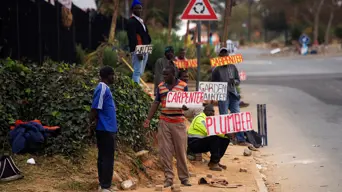MIYELANI HOLENI: SA has never budgeted for growth. It's high time we start
With prudent management of resources and strategic investments, the nation can unlock its full potential and pave the way for inclusive growth and development, ensuring a brighter tomorrow for all its citizens, writes Miyelani Holeni.

FILE: Job seekers wait on the side of a road holding placards showing their specialisation in Johannesburg, South Africa. Picture: MUJAHID SAFODIEN /AFP
Amidst the backdrop of economic constraints and global uncertainties, the budget for 2024/25 emerged as a pivotal document shaping South Africa's economic trajectory.
I extend my appreciation to the Minister of Finance, and the Treasury team, for their unwavering dedication in navigating these challenging times.
However, it is essential to delve deeper into the factors that have necessitated one to adopt a cautious optimism stance due to the negative implications for South Africa's economic sustainability.
One of the primary challenges confronting South Africa is its protracted period of subdued economic growth.
Over the past decade, the economy has struggled to surpass the 2% growth threshold, reflecting underlying structural impediments.
According to the World Bank, South Africa's GDP growth rate averaged just 1.2% annually from 2011 to 2020, significantly below the global average. This prolonged stagnation has compelled the government to adopt a prioritisation strategy, focusing on social spending to alleviate poverty and mitigate the adverse effects of unemployment.
Consequently, significant allocations have been directed towards social grants, healthcare, education, and law enforcement, overshadowing investments in growth-enhancing initiatives.
The widening chasm of inequality further exacerbates the urgency of addressing economic disparities.
According to Statistics South Africa, the country's Gini coefficient, a measure of income inequality, stood at 0.63 in 2020, one of the highest in the world.
Despite efforts to bolster social welfare programmes, the lack of commensurate support for economic growth drivers perpetuates the cycle of inequality and a vicious cycle of deepening poverty.
Without targeted interventions to stimulate economic activity and create sustainable employment opportunities, South Africa risks entrenching socio-economic divides that undermine long-term prosperity.
Moreover, South Africa's classification as a "slow grower" economy by McKinsey underscores the imperative of addressing structural bottlenecks hindering growth.
While the nation possesses the potential to attract significant capital inflows, the translation of these opportunities into tangible economic gains remains elusive.
Domestic constraints, such as electricity shortages, bottlenecks in the logistics value chain, and labour market inefficiencies, coupled with global economic headwinds, have conspired to constrain South Africa's growth potential, necessitating a recalibration of fiscal priorities.
In this context, the utilisation of the Gold and Foreign Exchange Contingency Reserve Account (GFECRA) has sparked a small flame of optimism.
The ability to leverage GFECRA to stabilise the budget amidst fiscal pressures underscores its role as a critical economic "instrument".
Managed by the South African Reserve Bank, GFECRA offered a lifeline of R150 billion to the South African fiscus during times of economic turbulence, enabling the government to meet its financial obligations without resorting to unsustainable borrowing. As of the end of the fiscal year 2023/24, GFECRA held approximately R500 billion in reserves which represents 8% of GDP in positive central bank equity.
However, while GFECRA provides a temporary reprieve, its utilisation raises broader questions about fiscal sustainability and long-term economic planning.
Rather than viewing GFECRA as a stopgap measure, there's a compelling case for transforming it into a catalyst for economic transformation. By establishing a Sovereign Fund from GFECRA, South Africa can channel resources towards strategic investments that catalyse sustainable growth, create jobs, and foster inclusive development.
This approach departs from the traditional approach of establishing sovereign funds from a commodity boom.
Norway established a sovereign wealth fund to manage revenues from oil extraction, contributing to long-term economic stability and prosperity. China and Singapore established their sovereign wealth fund from accumulated budgetary and trade surpluses. South Africa has an opportunity to utilise the positive central bank equity to kick-start its sovereign wealth fund that will stimulate economic growth, and enable National Treasury to budget for growth.
The reality is that "you get what you budget for" and we have never budgeted for growth as a country.
The budget for 2024/25 represents a critical juncture in South Africa's economic trajectory. While commendable strides have been made in navigating fiscal constraints, the path to sustained prosperity requires a holistic approach that addresses underlying structural challenges.
By leveraging GFECRA as a vehicle for transformative change and embracing innovative solutions, South Africa can chart a course towards a future defined by economic growth, prosperity, and shared opportunity.
With prudent management of resources and strategic investments, the nation can unlock its full potential and pave the way for inclusive growth and development, ensuring a brighter tomorrow for all its citizens.
It is imperative that stakeholders across sectors collaborate effectively to implement policies and initiatives that foster economic resilience and drive sustainable progress for generations to come.
Miyelani Holeni is the Group Chief Advisor at Ntiyiso Consulting.